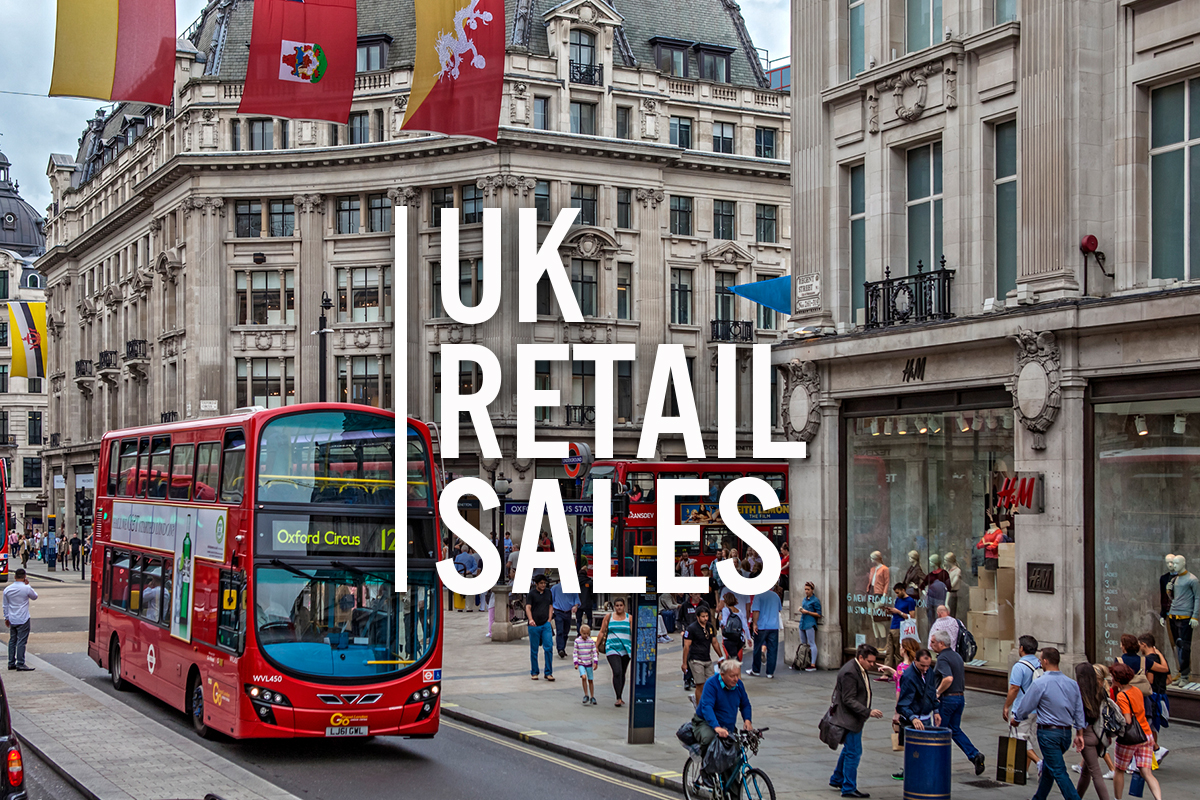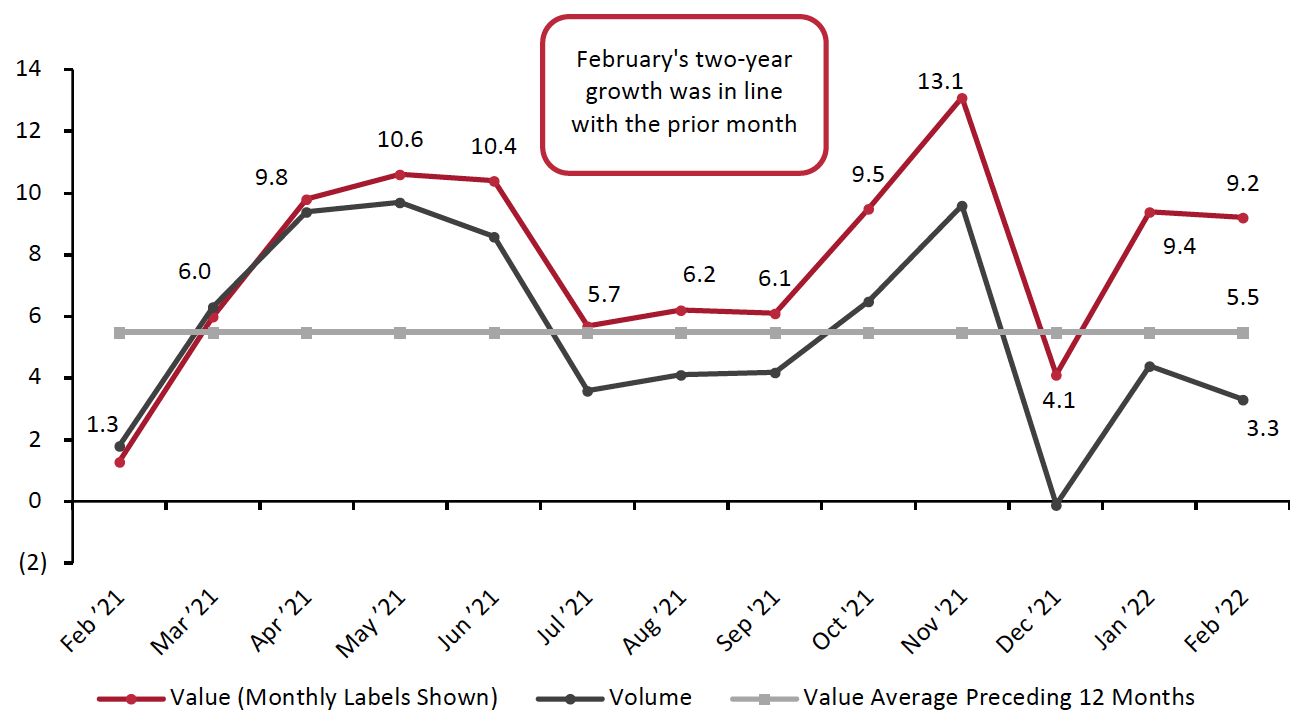
albert Chan
UK Retail Sales: February 2022
In February, total UK retail sales maintained momentum after a strong January. Year over year, total retail sales excluding automotive fuel grew 10.0%, marking another solid month of recovery against modest February 2021 comparatives when sales grew just 1.3%. On a two-year basis, February retail sales growth remained level with January, growing 9.2% against pre-pandemic February 2020 values.
While value growth was largely in line with January’s, volume growth slowed. In February, sales volumes grew 3.5% year over year, down from January’s 6.4 % year-over-year growth.
Last month, we noted that shop prices were rising at their fastest pace for 30 years, at 5.3% year over year in January. In February, the pace of retail inflation picked up further, to 6.3%.
Month over month, sales volumes declined 0.3%, according to the ONS. The slowed growth in sales volumes coupled with maintenance of overall retail sales growth reflects the impacts of rising prices in the UK.
Figure 1. Total UK Retail Sales (ex. Automotive Fuel and Unadjusted): YoY % Change [caption id="attachment_144248" align="alignnone" width="700"]
 Data in this report are not seasonally adjusted
Data in this report are not seasonally adjustedSource: ONS/Coresight Research[/caption] Against the more consistent comparatives of pre-pandemic February 2020, February 2022 retail sales growth was in line with a strong month of January, driven by a further return to normality with the worst of the Omicron variant over.
Figure 2. Total UK Retail Sales (ex. Automotive Fuel and Unadjusted): % Change from Two Years Ago [caption id="attachment_144249" align="alignnone" width="700"]
 Data in this report are not seasonally adjusted
Data in this report are not seasonally adjustedSource: ONS/Coresight Research[/caption] Retail Sales Growth by Sector The lockdown measures imposed in 2020 had a major detrimental impact on retail sales, causing certain sectors to see dramatic sales declines and skewing year-over-year growth numbers. In 2021, retail sales growth recovered, although some sectors remain below their pre-pandemic 2020 values. Clothing specialty retailers continued a strong path of recovery boosted by wider socializing and return to the office following the lifting of Covid-19 restrictions in January. Clothing specialty retailers recovered to slightly surpass pre-pandemic values this month. In February, sales at large clothing specialty retailers increased 105.4% from the previous year while sales at small clothing specialty retailers saw sales rise by 137.9%. In aggregate, clothing specialty retailers posted two-year growth of 0.4%. Footwear specialty retailers also recovered to surpass pre-pandemic values this month, posting a two-year sales growth of 1.2%. On a year-over-year basis, sales rose 98.7%. Sales at department stores/mixed-goods retailers rose by a modest 2.6% year over year. Compared to pre-pandemic values, the sector is on the brink of fully recovering but not there yet. On a two-year basis, sales declined marginally, by 0.6%. Grocery retailers witnessed a second consecutive month of sales declines. In February, sales declined by 3.3% compared to the prior year. Electrical goods specialists witnessed sales growth slow in February after a very strong January. In February, sales grew just 2.2%, down from January’s 21.8% year-over-year growth. Despite high year-over-year growth of 85.1%, sales at books and news stores remain below their pre-pandemic values. On a two-year basis sales growth declined by 28.3%. DIY and hardware stores sales declined 7.0% from a year prior but remained 14.2% higher compared to pre-pandemic February 2020. Figure 3. UK Retail Sales, by Sector: YoY % Change [wpdatatable id=1847] [wpdatatable id=1849]
*A small retailer is defined as one with fewer than 100 employees or with revenues of £60 million or less per year; all others are large retailers **A relatively fragmented sector, in which reported figures have traditionally been volatile Source: ONS
Online Retail Sales Decline by 16.9% E-commerce continued to struggle in February, although the ONS revised January’s online sales decline from 20.0% to 11.4%, painting a better portrait for online sales declines. In February, online sales declines continued, declining 16.9% from the prior year, marking the largest year-over-year decline in online sales recorded by the ONS since it started tracking online sales in 2006. Overall online sales declines were driven by a 29.7% decline in online sales at nonfood stores. Within nonfood stores, online sales by clothing stores declined 19.6% from the previous year, while household goods stores witnessed online sales decline by 44.7%. Food stores exhibited a sales decline of 23.8% from the prior year. As shown in Figure 4 below, online sales as a percentage of overall retail sales in February continued a downward trend. Online sales accounted for 27.6% of overall retail sales, its lowest proportion since March 2020, continuing a broad downward trend since its peak in February 2021, according the ONS.Figure 4. Online Retail Sales as % of Total Retail Sales [caption id="attachment_144251" align="alignnone" width="700"]
 Food and Nonfood data are for store-based sectors; All Retail total includes nonstore retail, which is not charted
Food and Nonfood data are for store-based sectors; All Retail total includes nonstore retail, which is not chartedSource: ONS[/caption] Covid-19 Lockdown Timeline Lockdown 1: The UK was put into lockdown on March 23, 2020, initially for three weeks, in an attempt to limit the spread of the coronavirus. Nonessential retail stores were closed. On April 16, the government extended the lockdown by another three weeks. On May 11, Prime Minister Boris Johnson announced that the government would begin easing restrictions in a phased manner, allowing nonessential stores to reopen from the start of June. However, garden centers were allowed to reopen May 13 and furniture stores May 23. On May 26, the government announced that all nonessential retailers in England and Northern Ireland—including department stores and small independent shops—would be allowed to reopen from June 15, but stores would need to implement measures to meet the necessary social distancing and hygiene standards. On June 23, Johnson announced that restaurants, pubs, museums, cinemas and hotels could reopen on July 4. On September 14, a new “rule of six” prohibited social gatherings of more than six people, unless they are from the same household. On September 22, Johnson outlined a slew of new restrictions in the wake of a fresh spike in the number of infections. These included the closing of bars, pubs and other hospitality services by 10:00 p.m., effective September 24. On October 7, the Scottish government implemented tighter restrictions, largely on the hospitality industry. Retail was not directly affected, although stores were requested to enforce two-meter distancing. On October 12, the UK government announced a three-tier lockdown system, which classified regions based on the severity of infection rates. In the week beginning October 19, a number of regions in England, including London and Manchester, moved into higher tiers of control, which include restrictions on households mixing and, in some cases, some service industries; however, these did not change the direct rules for retailers. On October 23, a 17-day lockdown began in Wales, with nonessential retailers being forced to close once more. Lockdown 2: On October 31, Prime Minister Johnson announced a second lockdown for England for the period November 5 to December 2. All nonessential retail was forced to close, “including, but not limited to, clothing and electronics stores, vehicle showrooms, travel agents, betting shops, auction houses, tailors, car washes and tobacco and vape shops.” Food shops, supermarkets, garden centers and certain other retailers providing essential goods and services could remain open. Nonessential retail could remain open for delivery to customers and click- and-collect. Hospitality venues such as restaurants, bars and pubs were forced to close but could still provide takeaway and delivery services. Also forced to close were entertainment venues, indoor and outdoor leisure facilities, and personal care services. Following the lockdown, UK regions were placed into different tiers, each of which had different restrictions. On December 8, the UK’s National Health Service started vaccinations, with the aim of vaccinating the most vulnerable groups of people by February 15, 2021. On December 21, the UK government scrapped a planned easing of rules on the mixing of households over the Christmas period. In England and Scotland, households in many areas were banned from mixing; in some areas, households could mix on Christmas Day only. The devolved Welsh and Northern Irish administrations implemented their own restrictions. Lockdown 3: On January 4, 2021, Johnson announced a lockdown in England, effective January 5 and with an unspecified end date but with laws formally expiring on March 31. Scotland, Wales and Northern Ireland also implemented lockdowns. On January 19, Scotland’s First Minister Nicola Sturgeon announced that that country’s lockdown would be extended until at least the middle of February. On January 27, the government announced that travelers arriving from “red list” countries must quarantine in hotels specified by the government. On February 22, the government laid out a roadmap to ending lockdowns in England. Restrictions will start to be eased from March 29, nonessential retail stores and services such as hairdressers will be allowed to reopen from April 12, and final restrictions will be ended on June 21. On March 25, the UK lowered the Covid-19 risk level from four to three on a scale of five. On April 12, the government eased raft of restrictions across England, with gyms, zoos, theme parks, pubs and restaurants allowed to reopen for outdoor service and shops and hairdressers again permitted to serve customers. On April 20, Sturgeon announced that Scotland will move to Covid protection Level 3 from Level 4 on April 26, meaning hospitality venues such as cafés, pubs and restaurants and beauty salons can reopen. On May 17, England eased restrictions further with groups of up to six people from different households allowed to socialize indoors, pubs and restaurants can serve indoors and entertainment venues such as museums, cinemas, and theatres can reopen. On June 14, England delayed the final stage of easing lockdown restrictions by month, until July 19, due to the increase in cases of the more transmissible Delta variant. After more than a year under some form of restriction, England lifted almost all remaining Covid-19 rules on July 19, 2021. This included the opening of nightclubs and lifting capacity restrictions on big events and performances. On December 13, British health secretary Sajid David announced that approximately 200,000 people nationwide had tested positive for the Omicron variant. On December 14 Prime Minister Boris Johnson put forth a new policy of mask mandates and proof of vaccine certification to enter nightclubs and other crowded public spaces. On January 19, 2022, Prime Minister Johnson lifted the mask mandate and no longer required proof of vaccination to enter large or crowded places, signaling the worst of the Omicron variant was behind in the UK. On February 24, 2022, the legal requirement to self-isolate upon testing positive was removed in England as part of the government’s “Living with Covid” plan. Contact tracing of those testing positive and self-isolation for contacts of positive cases also ended in England. On March 18, 2022, all international travel restrictions, such as passenger locator forms and Covid-19 testing for unvaccinated travelers, were removed. On March 24, 2022, Covid-19 provisions attached to statutory sick pay were removed in England. Guidance on workplace risk assessments was also removed. From April 1, 2022, free universal Covid-19 testing will be removed in England.